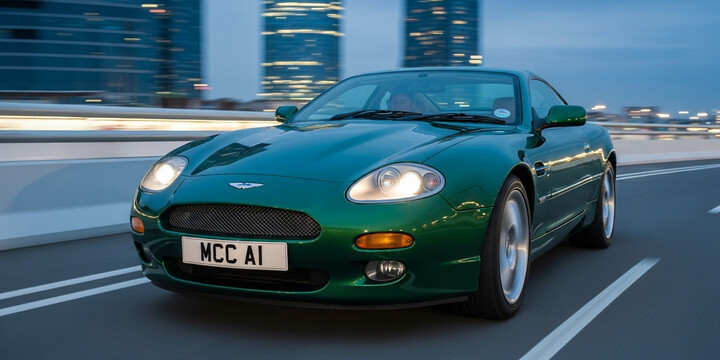
ASTON MARTIN DB7 (1996-04)
The ASTON MARTIN DB7 (1996-04) is a stunning grand tourer that stands out in the UK classic and luxury car market. Known for its elegant design and sporty performance, this vehicle is ideal for enthusiasts seeking a blend of style, comfort, and driving pleasure. With a rich heritage rooted in craftsmanship and luxury, the DB7 offers a smooth ride perfect for long-distance cruising or weekend drives. It’s typically favored by collectors, car enthusiasts, or those looking for a statement piece rather than a daily commuter, making it a great choice for those who appreciate timeless British design and engineering.
What makes the ASTON MARTIN DB7 (1996-04) particularly notable is its sophisticated appearance combined with solid performance. It’s often compared favorably to other luxury GTs of its era, thanks to its refined craftsmanship and exclusivity. The average valuation of around £25,325 and impressive average mileage of just under 47,400 miles reflect its status as a desirable, well-maintained collector’s item or luxury used car. Whether you’re after a car with a distinctive presence or a vehicle that offers a premium driving experience, the ASTON MARTIN DB7 is an excellent option for those who want to stand out on UK roads.

average use

The most recent mileage data for the Aston Martin DB7 (1996-04) indicates that the majority of these vehicles are relatively low-mileage. The largest proportion, 23.5%, falls within the 40,000 to 50,000-mile range. Notably, vehicles with mileage between 20,000 and 30,000 miles account for 15.1%, while those between 50,000 and 60,000 miles make up nearly 14%. Very high mileage vehicles—over 150,000 miles—are quite rare, comprising less than 1.5% of the sample, with the highest being in the 160,000 to 170,000-mile range at just 0.4%. Overall, this suggests that Aston Martin DB7s tend to remain relatively low mileage, which is typical for collectible or luxury vehicles of this era.

vehicle values

The data presents private sale price distribution percentages for Aston Martin DB7 (1996-04), indicating how often each price range appears in the market. The majority of sales cluster around the £18,000 to £22,000 range, with notable percentages—14.3% in the £18,000-19,000 bracket and 10.8% in the £19,000-20,000 bracket—highlighting these as common valuation points. Very low percentages are seen at price points below £7,000 and above £30,000, suggesting fewer sales in these extremes. Overall, the data reflects a concentration of private sale activity in the mid-£18,000 to £20,000 range, with a tapering distribution at the lower and higher ends.

production years

The data for Aston Martin DB7 vehicles manufactured between 1996 and 2004 shows that the majority of the sample was produced between 2000 and 2003, with notable proportions in 2000 (26.7%) and 2001 (25.5%). There is a steady decline in the number of vehicles manufactured after 2003, with only very small percentages recorded for 2004 (10.4%) and an even smaller, almost negligible percentage for 2007 (0.4%). This suggests that most of the Aston Martin DB7s in the sample were built during the early 2000s, with limited manufacturing or reporting beyond that period.

colour popularity

The data indicates that the most common paint colours for the Aston Martin DB7 (1996-2004) are Silver (37.5%), Blue (27.1%), and Green (21.9%), collectively accounting for over 86% of the vehicles, suggesting these shades are particularly popular among owners. Less frequently seen colours include Black (7.2%), Red (2%), Grey (3.2%), and small percentages of Bronze, Yellow, and Maroon, each at around 0.4%. This highlights a tendency towards classic, understated hues, with a preference for silver and blue over more vibrant or uncommon colours.

ownership cycle

The data on registered keepers for the Aston Martin DB7 (1996-04) reveals a diverse distribution. The most common number of keepers is 6, accounting for 17.5%, closely followed by 4 and 5 keepers at 16.7% each, and 3 keepers at 13.9%. Notably, a small proportion of vehicles have up to 11 registered keepers, with the smallest group (11 keepers) representing just 0.8%. A minority of cars appear to have only 1 or 2 keepers, suggesting some vehicles are relatively well-maintained or retained over longer periods, while others change hands more frequently. Overall, the data indicates a relatively stable ownership pattern with some variation.

engine choices

The data indicates that for Aston Martin DB7 models manufactured between 1996 and 2004, the vast majority (99.6%) are equipped with an engine capacity of 5,935 cc, with a small minority (0.4%) having a capacity of 5,835 cc. Additionally, all vehicles in the sample use petrol as their primary fuel type. This suggests a high level of consistency in engine specifications for this model range, primarily favoring the 5,935 cc petrol engine among owners and manufacturers.












